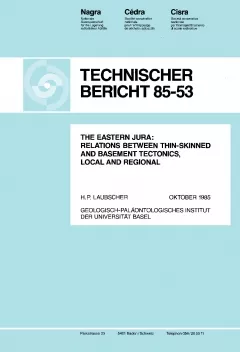
Technical Report NTB 85-53
The Eastern Jura:Relations between thin-skinned and basement tectonics, local and regional
The thesis area of Hans Cloos in the eastern Jura straddles the boundary between the Paleogene structures of the Tabular Jura, a part of the southeastern end of the Rhine graben, and the Neogene folds and thrusts of the Folded Jura. A recent reflection seismic survey in the area adjacent to the east provides new information on the subsurface structure and the relation between three superposed tectonic events. The main boundary fault zones of a deep and complexly faulted late Paleozoic trough, trending ENE, were reactivated in the early Tertiary. Faulted flexures and small folds, rooted in the basement and Paleozoic, with an amplitude of usually 100 to 300 m were produced, rather than the normal faults typical for the extensional fields of the Rhine-Bresse graben system in the west and the Bavarian Molasse basin in the east. This suggests their being part of a transform zone between these extensional fields. During Jura decollement in the Neogene these inherited, deeply rooted sub-decollement structures remained passive: their small size is kinematically incompatible with the intense subsequent thrusting and folding of the thin Mesozoic-Tertiary skin. However, thrust ramps were apparently nucleated at the respective southern foot of these Paleogene flexures and folds. The best defined and simplest of these composite structures is the Mandach structure within the Tabular Jura, a south-facing flexure of about 300 m relief, developed in the Paleogene by reactivation of the northern border fault zone of the Paleozoic trough. In the Neogene a north-vergent decollement thrust, which is connected with the regional Jura decollement in the middle Triassic evaporites, was initiated at its site. The southernmost nucleation point at the southern limit of the folded Jura was apparently re-used after intervals of northward spreading of decollement. There is evidence that a similar succession of events took place in the central and western Jura as well. Regionally, the boundary faults of at least some of the Paleozoic troughs were reactivated in the early Tertiary as transform zones linking the Rhine-Bresse-Rhone graben systems, while these early Tertiary tectonics in turn provided important boundary conditions for Jura decollement, Which is the result of northward propagation of the Europa-Africa collision zone in the Neogene.
